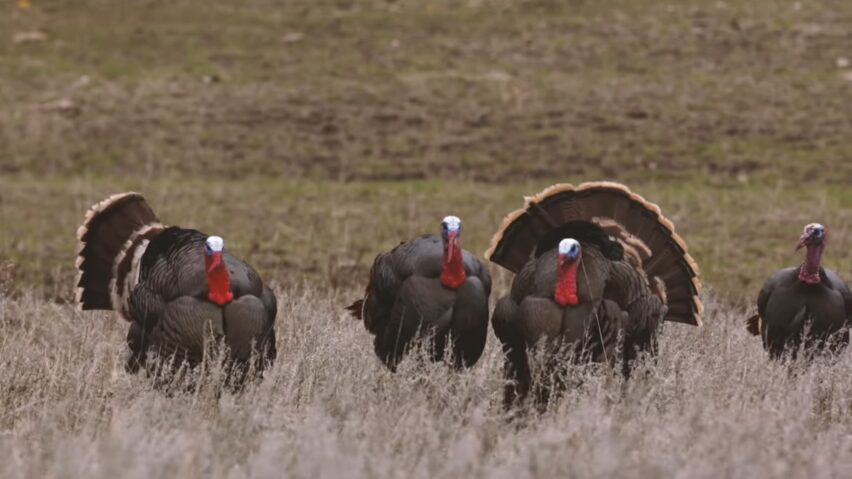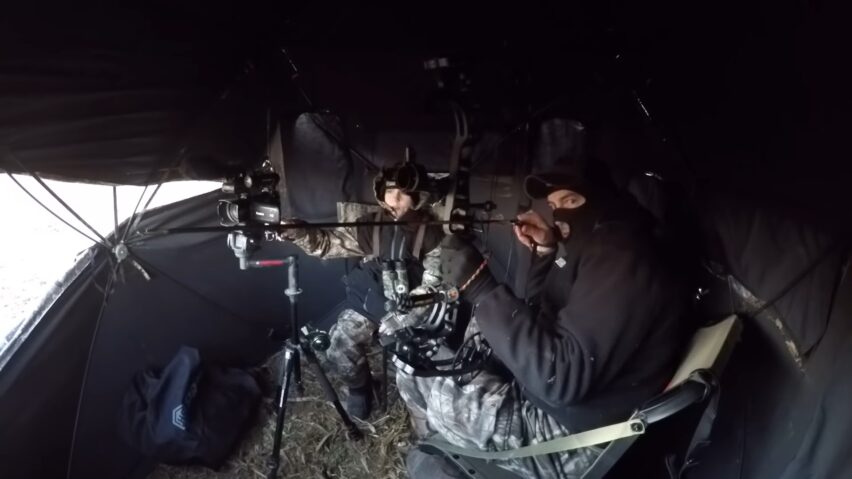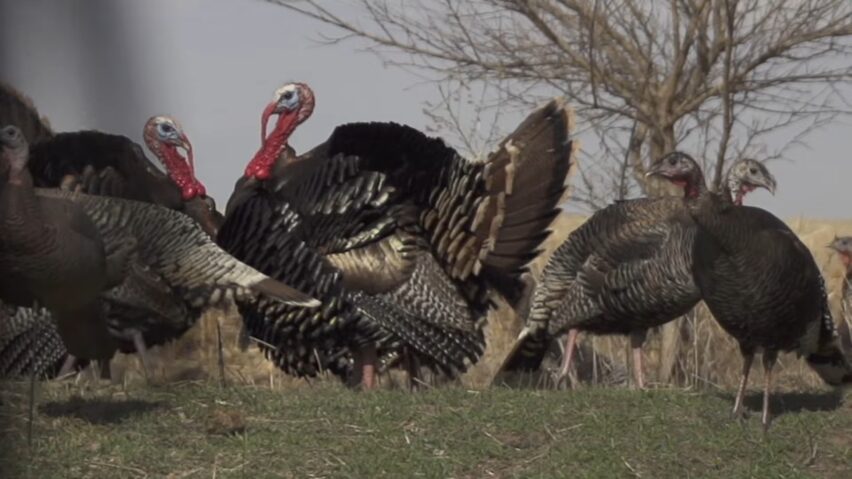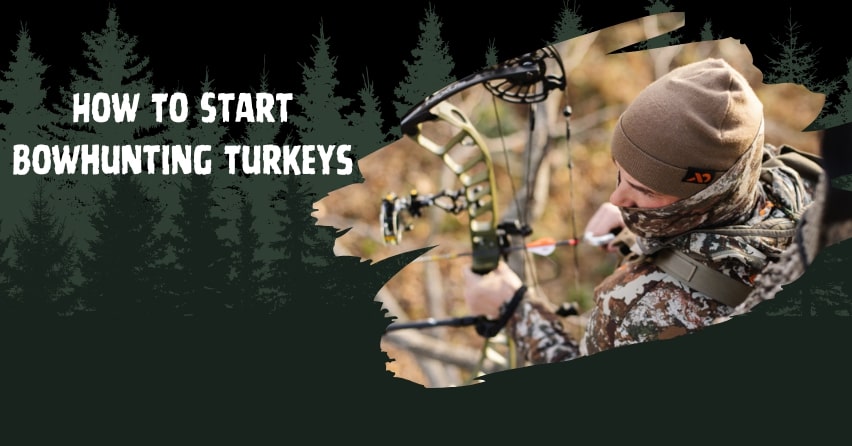Bowhunting turkeys is a thrilling pursuit that invites you to truly immerse yourself in the natural world. This hunting method combines a deep respect for wildlife, a fascination for the complexities of avian behavior, and a love of archery’s ancient and revered discipline.
The Basics Explained

Bowhunting is a unique form of hunting that requires a very particular set of skills. Unlike rifle hunting, where a turkey’s vital areas can be reached from a distance, bowhunters must get much closer to their quarry, typically within 30 yards, to deliver an effective shot. This necessitates an intimate understanding of the animal’s behavior, effective concealment techniques, and the ability to make accurate shots under pressure.
To be successful, you’ll need to understand the turkey’s annual cycle. In the spring, males, or gobblers, are on the prowl for females and are, therefore, more susceptible to calling. This makes spring the ideal time to bowhunt them.
However, it’s crucial to know that different states have different hunting seasons, and you must adhere to these regulations. Make sure to consult with your local Department of Natural Resources to determine the correct dates for turkey hunting in your area.
Another fundamental aspect of hunting is the choice of bow. While traditional bows, compounds, and crossbows all have their place in hunting, many bowhunters prefer the compound bow for its mix of power and accuracy. It’s also essential to choose the right arrow and broadhead combination for hunting turkeys, which is something we’ll dive into in more detail later.
Essential Gear and Equipment You’ll Need
Firstly, let’s focus on the core of your hunting equipment – your bow. As mentioned before, compound bows are favored by many turkey hunters for their balance of speed, power, and precision. However, the choice between a traditional, compound, or crossbow will largely depend on your own comfort and proficiency. You should shoot with what you’re most accurate and comfortable with, bearing in mind the specific demands of turkey hunting.
The right arrows and broadheads are essential. Arrows should be matched to your bow’s draw weight and length for optimal flight characteristics. Broadheads, on the other hand, should be designed for maximum impact and a wide cutting diameter, crucial for quickly and humanely dispatching a turkey. Expandable broadheads are commonly used due to their wide wound channels, which are more forgiving of less-than-perfect shot placements.
Other crucial equipment includes camouflage clothing to blend in with your surroundings and a turkey call to lure gobblers into range. Decoys can also be effective, particularly during the spring mating season, when a lifelike hen or jake (juvenile gobbler) decoy can help to draw a dominant gobbler into shooting range. Finally, a comfortable, portable ground blind can provide concealment, and many hunters also carry a rangefinder to ensure accurate distance measurement for their shots.
Scouting Techniques for Finding Hotspots

Scouting is a critical part of any successful hunt, and turkey hunting is no exception. The first step in scouting is understanding the animal’s habitat preferences. Turkeys require a mix of woodland and open spaces, like fields or clearings, where they feed, strut, and mate. When scouting, look for signs such as feathers, droppings, scratchings in the dirt, and dusting areas where they roll in loose soil.
Many hunters swear by the pre-dawn and dusk “roost-check” technique. Turkeys fly up to roost in trees at night and fly down at dawn. By positioning yourself near potential roosting sites before first light or at sunset, you can listen for the distinct sounds of turkeys on the roost. In the spring, gobblers often announce their presence at dawn with vigorous gobbling, which can give away their location.
Another effective scouting technique is to use trail cameras. Set up these cameras in places where you have found signs of turkeys or near potential food sources. Trail cameras can give you valuable information on the number of birds in an area, their daily routines, and the presence of any mature gobblers. Using this information, you can plan your hunting strategy effectively.
Mastering the Art of Turkey Calling with a Bow
Learning to call turkeys effectively is an art form that takes practice and patience. The key to effective calling is to mimic the sounds that turkeys make naturally. Calls range from yelps and purrs to clucks and gobbles, each conveying a different message in the turkey’s social network. While learning all of these calls takes time, even mastering a basic yelp can get you started in the turkey woods.
There are a variety of turkey calls available, including box calls, slate calls, mouth calls, and even electronic calls. Each has its strengths and weaknesses, and the choice largely depends on personal preference and the specific hunting situation. It’s worth learning to use at least a couple of these calls, as having a range of sounds at your disposal can make you more adaptable in the field.
Keep in mind that calling turkeys is as much about subtlety and timing as it is about producing the right sounds. Overcalling can scare them away, as can calls that sound unnatural or are made at the wrong time. Listening to real turkeys and practicing your calling in a variety of situations will help you hone this critical skill.
Setting Up Effective Ground Blinds
Ground blinds are a crucial tool for turkey hunters. They help you stay concealed and give you the freedom to move slightly without being spotted. When it comes to choosing a ground blind, consider portability and concealment. The blind should be easy to set up and take down, and it should blend in with its surroundings.
Once you’ve chosen your ground blind, the next step is to decide where to set it up. Ideal locations include near food sources, along travel corridors, or close to known roosting areas. However, turkeys have excellent vision, so it’s essential to fully camouflage the blind by brushing it in with surrounding vegetation.
The position of your blind in relation to the sun is also important. You don’t want to be squinting into the sun when a turkey approaches. Ideally, set up your blind so that you’re facing north or south. This way, the sun will rise to your left and set to your right, ensuring that it’s never directly in your eyes during prime hunting hours.
Strategies for Ambushing With a Bow

Ambushing turkeys requires careful planning and strategy. One of the most effective strategies is to set up near a roosting site in the early morning. Turkeys typically fly down from their roosts at dawn, often landing in the same area each day. By setting up your blind within range of this landing zone, you can get a shot opportunity before the day has barely begun.
Decoys can be a useful tool in an ambush strategy. A gobbler decoy can provoke a dominant male turkey to come and challenge the “intruder,” while a hen decoy can lure a gobbler in hopes of mating. Place your decoys within shooting range of your blind, but remember not to put them too close, as this may alert a suspicious turkey to your presence.
Remember that patience is key when ambushing turkeys. These are wary birds, and they might take their time approaching your setup. Wait for the right moment when the turkey is within range and presents a clear shot before drawing your bow.
Identifying and Capitalizing on Behavior Patterns
A deep understanding of turkey behavior is invaluable to a bowhunter. Turkeys have routines and habits, and learning these can drastically increase your success in the field. For example, turkeys typically feed in the morning and evening, often in open areas where they can keep an eye out for danger. Setting up along the edge of a field can offer excellent shot opportunities.
Turkeys also follow specific routes between feeding, roosting, and strutting areas. Identifying these trails and setting up an ambush along them can be an effective strategy.
Spring is the mating season for turkeys, and this significantly influences their behavior. Males are more vocal during this period and more likely to respond to calling. They’re also more likely to approach decoys in their desire to find a mate or chase off rivals. Capitalizing on these behavioral quirks can make your spring hunt much more successful.
Shot Placement Tips
The critical area for a turkey is smaller than that of most big game animals, so shot placement is crucial. Ideally, you want your arrow to hit the turkey’s vitals, which are located in the center of the body, just above the drumsticks. An arrow placed here will usually result in a quick, clean kill.
The orientation of the turkey when you shoot, can greatly affect your shot placement. A broadside shot is often the best opportunity, as it offers the largest target area. If the turkey is facing away from you, a shot at the base of the tail can reach the vitals, but this is a smaller target and requires greater precision.
One common mistake among novice bowhunters is shooting too high on a turkey’s body. This often results in a “high back” shot that can wound a turkey without being lethal. Practice your aiming at 3D turkey targets to get a feel for the correct shot placement.
Tracking and Recovering Prey After a Bow Shot
Once you’ve taken your shot, the next step is to recover your turkey. Even with a perfect shot, turkeys may run or fly a short distance before expiring. When this happens, it’s important to be patient and give the bird time to expire before attempting to recover it.
After the shot, mark the direction in which the turkey traveled and wait for at least 30 minutes before following. When you do start tracking, look for signs such as blood, feathers, and tracks. A blood trail can be difficult to follow, especially in thick vegetation, so take your time and look carefully.
If you can’t find your turkey after a reasonable search, it’s time to call in help. Other hunters, friends, or even a trained tracking dog can greatly increase your chances of recovering a wounded turkey. Always make every effort to recover any animal you shoot – it’s both an ethical obligation and a legal requirement in most places.
Safety Precautions and Ethical Considerations
Safety should be your foremost concern when bowhunting turkeys. This starts with ensuring that you’re proficient with your bow and capable of making a clean, lethal shot. Practicing regularly and understanding your equipment’s limitations can greatly reduce the risk of wounding an animal.
Hunting from a ground blind presents its own safety challenges. Always make sure your shooting lanes are clear and that there are no obstructions that could deflect your arrow. Also, be aware of what’s beyond your target. Even a turkey arrow can travel a significant distance if it misses or passes through its target.
From an ethical standpoint, it’s important to respect the animals you hunt and the environment in which they live. This means adhering to hunting regulations, striving for quick, clean kills, and avoiding any actions that might unnecessarily stress wildlife or damage their habitat.
Tips for Success
Patience is perhaps the most essential virtue for a turkey bowhunter. You might spend hours in a blind or calling without response before you get your chance. Stay patient, stay alert, and trust in your preparation and your strategy.
Another tip is to practice as much as you can. This means practicing your shooting, of course, but also your calling, your setup, and even your patience. The more familiar you are with every aspect of the hunt, the more comfortable you’ll be when the moment of truth arrives.
Lastly, never stop learning. Even the most experienced hunters can always learn something new, whether it’s a new calling technique, a new understanding of turkey behavior, or a new piece of gear that could give them an edge. Keep an open mind and always be ready to learn from your experiences and from the experiences of others.
Final Words
Bowhunting turkeys is a challenging yet rewarding pursuit that offers a chance to engage with nature in a unique and intimate way. It requires patience, skill, and deep respect for these magnificent birds and the environments they inhabit. Whether you’re new to bowhunting or an experienced archer, the thrill of drawing your bow on a strutting gobbler is an experience unlike any other.
Remember that as a hunter, you’re part of a long tradition of stewardship and respect for the natural world. Hunt ethically, hunt safely and treasure each moment in the turkey woods. The challenge of bowhunting is significant, but the rewards are immeasurable.

